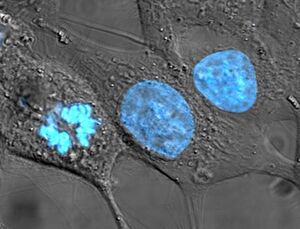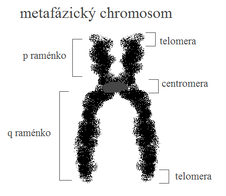Cell nucleus

The cell nucleus , or nucleus , is contained in every cell that can divide. The genetic information of the cell is stored in the nucleus. The nucleus is the largest and most important cell organelle.
The three basic tasks of the kernel include:
- regulation of cell differentiation and maturation,
- replication and transfer of genetic information to a new cell,
- synthesis of messenger RNA ( mRNA ), transfer RNA ( tRNA ) and ribosomal RNA ( rRNA ) and their transport into the cytoplasm.
Core components[edit | edit source]
- Nucleolus
- chromatin (chromosomes),
- Nuclear envelope ,
- ribosomes - they can be attached to the nuclear envelope, endoplasmic reticulum or just loosely stored in the cytoplasm (either individually or as polyribosomes (polysomes)).
Nucleolus[edit | edit source]
A nucleolus is an unbounded nuclear structure visible in interphase. It is stored either loosely in the core or mounts on its inner membrane. Rather than a separate organelle, it is a functional region of the nucleus, which is made up of sequences of acrocentric chromosome satellites (in humans, chromosomes 13, 14, 15, 21 and 22). These regions contain genes for rRNA, hence the main function of the nucleolus, which is rRNA synthesis . The resulting rRNA is involved in the formation of the mature ribosome in the cytoplasm.
Chromatin[edit | edit source]
Chromatin is visible as a compact "nuclear mass" during interphase. Chromatin itself is a complex of DNA and proteins . According to the degree of condensation (related to transcriptional activity in a given region), chromatin can be divided into:
- euchromatin (optically bright parts of chromatin with higher transcriptional activity)
- heterochromatin (optically dark parts of chromatin with low transcriptional activity)
Chromatin further spirals into the familiar form of chromosomes during mitosis (or meiosis ), when we can observe typical structures (X-shaped) of chromosomes, formed by two sister chromatids joined in the centromere region. The centromere is located at the bend. Each cell has a characteristic number of chromosomes (the number of chromosomes is a species-specific feature). A diploid set of chromosomes is typically present in the somatic cells of eukaryotic organisms, we denote it as 2n. This is because each chromosome is contained twice in the cell (one from the father, one from the mother). During the formation of sex cells (using meiosis), the number of chromosomes is reduced by half - only the haploid number is present (from each pair of chromosomes, only one chromosome remains in the sex cell).
Nucleic acids[edit | edit source]
Nucleic acids , along with proteins, are the most important macromolecular compounds. It is used to store genetic information, such as cellular memory. We distinguish two types of nucleic acids:
DNA occurs in the cell nucleus, where it forms a major component of chromosomes. RNA is found in smaller amounts in the cell nucleus, mainly in the nucleolus. Most RNA is contained in the cytoplasm. We distinguish three basic types of RNA:
- messenger RNA (mRNA) - serves primarily to transfer genetic information from the nucleus to the cytoplasm;
- transfer (tRNA) - used to transfer amino acids to the site of protein synthesis, to ribosomes;
- ribosomal (rRNA) - is contained in ribosomes.
We distinguish between DNA synthesis (ie, replication) and the transfer of genetic information from the structure of DNA to the structure of RNA (transcription).
- Transcription is the transfer of genetic information from the structure of DNA to the structure of mediator RNA. DNA has such a huge molecule that it cannot pass from the nucleus to the cytoplasm. Therefore, the DNA will unravel at a particular site (depending on what genetic information is to be removed from the nucleus) and an additional mRNA strand will be formed according to one untied strand of DNA. The mRNA then enters the cytoplasm from the nucleus.
Nuclear Envelope[edit | edit source]
The nuclear envelope has two leaves - outer and inner. Among them is the perinuclear cistern (perinuclear space). Inside is the mass of the nucleus ( caryoplasm ). The outer membrane somewhere freely passes into the membrane of the granular endoplasmic reticulum. The nuclear envelope is permeated by a relatively large number of pores (so-called nuclear pores). By these, the nucleus communicates with the cytoplasm.
Links[edit | edit source]
[edit | edit source]
References[edit | edit source]
- LANGMEIER, Miloš. Základy lékařské fyziologie. 1. edition. Grada Publishing, a.s, 2009. 320 pp. ISBN 978-80-247-2526-0.
- TROJAN, Stanislav. Lékařská fyziologie. 4., přeprac. a uprav edition. Grada Publishing, a.s, 2003. 772 pp. ISBN 80-247-0512-5.

